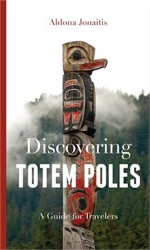Article Origin
Volume
Issue
Year
Discovering Totem Poles: A Traveler’s Guide
Written By Aldona Jonaitis
Douglas & McIntyre Publishers Inc.
Book Review By Christine McFarlane
“Discovering Totem Poles: A Traveler’s Guide” is the first guidebook to focus on the complex and fascinating histories of the specific totem poles visitors encounter in Seattle, Victoria, Vancouver, Alert Bay, Prince Rupert, Haida Gwaii (Queen Charlotte Islands) Ketchikan, Sitka and Juneau.
Author Aldona Jonaitis says that “this book is intended to present the histories of a number of poles, focusing on how each one came about as the result, in part of the interactions between Native and non-Native people.”
It debunks common misconceptions about totem poles and explores the stories behind the making and displaying of 90 different poles. Each section of this guidebook is titled so that the reader is given an indication of what specific theme will be discussed.
Some of that discussion includes why poles are raised in Native communities, how they communicate information about the history and prestige of the families who own them, and how the actual raising of a pole is a great event.
She speaks briefly about the relationship of the totem poles to laws that limited Native freedoms, the ill effects of colonialism on Native traditions, and the dispossession of Native lands to the current resurgence of Native control over their heritage.
Jonaitis starts with the story of a Seattle totem pole at Pioneer Square and explores the intriguing history behind the raising of that pole, which includes theft, deceit and arson. The story behind this particular totem pole relays how “before 1899, the original of this Tlingit pole stood in the village of Tongass, located in the southernmost region of the Alaska panhandle. That year, a group of Seattle businessmen went north on a steamship trip to investigate possibilities for increasing trade and investment in Alaska,” and “stopping in Tongass and seeing few people, decided the village was abandoned and that they could take whatever seemed interesting.”
The theft of this pole and its transfer to Seattle by steamship and its intriguing journey back home is just one example of the stories collected in this book.
Another story speaks of a time in 1956, when a visionary British Columbian anthropologist by the name of Wilson Duff “traveled to the remote, uninhabited community of Sgaang Gwaii (Ninstints) on the farthest southern tip of Haida Gwaii, where an impressive stand of thirty totem poles still stood,” and how in the late 19th century, missionaries and government officials encouraged the Haida to stop carving poles and to cease all traditional ceremonies like potlatches.
It was by the mid-20th century that this encouragement was being recognized as a larger attempt at cultural destruction that bordered on cultural genocide, and “in part to correct such past injustice and to preserve what had been almost entirely destroyed, Duff and his colleagues wanted to salvage these magnificent carvings, such as the totem poles of Sgaang Gwaii.”
Unlike other guidebooks, this book demonstrates that “the totem pole is not a category of Native art invented hundreds of years ago that maintained its original significance, but is instead, a type of art that has over the decades been transformed by the colonial encounter.”
Discovering Totem Poles: A Guide for Travelers is published by D & M Publishers Inc and is available in paperback and e-book format. It is 112 pages.
- 3965 views

